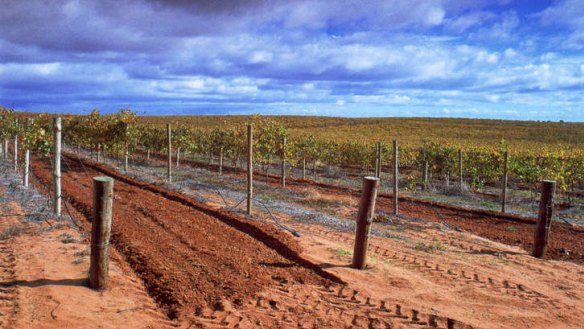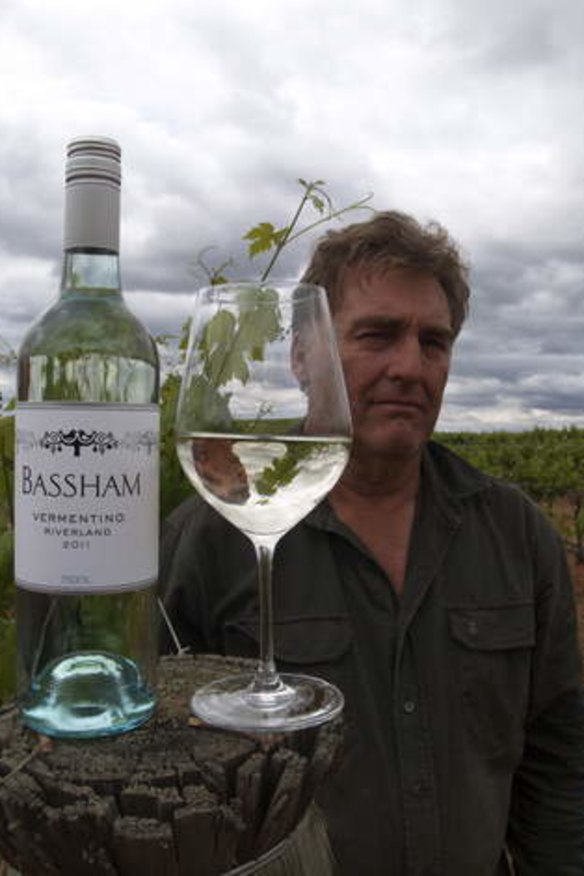Riverland winegrowers switch on to montepulciano
Using heat-loving, ''alternative'' grape varieties has rewarded South Australian growers - and wine drinkers.

Riverland winegrowers Bruce and Val Bassham are going the full monty. Montepulciano, that is. The montepulciano grape, whose home is the Abruzzo region in central eastern Italy, has taken enthusiastically to the Riverland and the Basshams reckon it's one of their best wines. They sell it for $24 under their Bassham Wines label. The 2012 is a fine wine of deep colour and good intensity of flavour, structured and seamless, with modest alcohol (13.5 per cent) and more savouriness than some of the ultra-fruity Riverland wines.
Bassham also has an excellent '13 nero d'avola - again savoury, medium-full bodied, dark and flavoursome, and a popular '12 lagrein which is brilliantly coloured and brightly, almost stridently, fruity.
Bruce Bassham is a third-generation grapegrower in the South Australian Riverland, at Barmera. His grandfather was a soldier settler, and the family will soon celebrate 100 years in the region.

Apart from the family's established 10-hectare vineyard, he and Val planted a new organic vineyard in 2001: 40 hectares on beautiful red soil and surrounded by native scrub - no neighbouring vines and hence easier to maintain its organic integrity.
Encouraged by the big wineries, they planted a lot of chardonnay but, by 2007 when the vines were producing, ''the market for chardonnay had fallen through the floor'', says Bruce. By then they were growing 700-800 tonnes a year, but they bit the bullet and grafted a lot of vines over to ''alternative'' varieties, mostly Italian. By then, the Basshams were in the first year of their three-year organic conversion. Big changes were happening.
In the summer of 2008 they made a trip to Chalmers vineyard near Mildura on a 47-degree day, and it was easy to see which varieties coped with the heat, Val laughs. They planted those: fiano and vermentino for white wines, lagrein, montepulciano and nero d'avola for red.
''At the time, grape prices in the Riverland were falling, but ours were increasing, so it was worth doing,'' Bruce says. The worst financial year was 2009, mainly because of a peak in water prices. ''We had virtually no cash flow that year.''
But, while most growers had to take what was offered by the wineries, ''we were able to sit down and negotiate for what we wanted''.
Montepulciano is the best variety from many viewpoints: it's drought tolerant and has a low water requirement; it picks beautifully with no juicing. ''It's very happy here: it starts ripening at the end of the season and it's ripening in the cool (which is good for its flavours and aromas and acid retention). It thrives when shiraz is turning up its toes.''
Bassham sells montepulciano grapes to Orlando, Angove and Salena Estate. Orlando would take it all if they could, but Bruce is happier sharing it around because it gives him power to negotiate price. A McLaren Vale winery takes some and pays top price: $1000 a tonne. ''Monty is a standout. It's the variety we can hang our hat on. The cooler regions can't compete with us because it ripens so late - early April - and they can't get it properly ripe.''
Lagrein, which is native to northern Italy, has also been a big success: it won the trophy for best organic red at the Australian Alternative Varieties Wine Show in 2012.
And fiano is the most successful white variety from the marketing viewpoint. It's easy to sell. Indeed, Bruce's ambition is to wean people off sauvignon blanc and onto fiano. The 2013 Bassham fiano and vermentino dry whites and montepulciano rose are all high-quality wines.
All of the new varieties are better for the Riverland for water use, especially monty. ''In the old days, we grew sultanas, currants, doradillos; now it's cabernet, shiraz, chardonnay and semillon, and the alternative varieties monty, graciano, grillo, vermentino and nero d'avola.'' It's a whole new ball game. They use much less water per hectare of vines than they used to, plus the new vineyard is organic. ''I never enjoyed the idea of spraying chemicals - although we still do on the home block. We have to spray weedicide under the vines (because they can't cultivate), but I'd be all organic if I could.''
The wines off the new organic vineyard don't have the word organic on the label: ''It's the grape variety that sells the wine, not organics.''
And it's those varieties that make the difference between Bassham's grapes being in demand and not. And worth more money: it's estimated the Basshams are making $200-$300 a tonne more than other growers, a significant difference in viability.
Bassham's wines are made at two local wineries: Salena Estate, where Melanie Kargas is winemaker, and by Eric Semmler at the Semmler family's 919 Wines.
Bassham wines are sold direct, and in local restaurants and liquor outlets. Delivery is by Australia Post with a two-bottle minimum. The reds are all $48 for two bottles; the whites $40; postage extra. See basshamwines.com; 0417 883 706.
